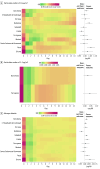Short-Term Exposure to Ambient Air Pollution and Antimicrobial Use for Acute Respiratory Symptoms
- PMID: 39240563
- PMCID: PMC11380104
- DOI: 10.1001/jamanetworkopen.2024.32245
Short-Term Exposure to Ambient Air Pollution and Antimicrobial Use for Acute Respiratory Symptoms
Abstract
Importance: Ambient air pollution and antimicrobial resistance pose significant global public health challenges. It is not known whether ambient air pollution is associated with increased consumption of antimicrobials.
Objective: To assess whether a short-term association exists between ambient air pollution levels and antimicrobial consumption among the general population seeking primary care consultations for acute respiratory symptoms.
Design, setting, and participants: This 2-stage cross-sectional ecological time series analysis study using data on daily ambient air pollution and antimicrobial consumption was conducted in the 11 largest cities in Catalonia, Spain, from June 23, 2012, to December 31, 2019, among all inhabitants aged 12 years or older. Statistical analysis was performed from November 2022 to December 2023.
Exposures: Daily ambient air pollution (particulate matter of 10 μg/m3 [PM10], particulate matter of 2.5 μg/m3 [PM2.5], and nitrogen dioxide [NO2]).
Main outcomes and measures: The main outcome was antimicrobial consumption associated with primary care consultations for acute respiratory symptoms in the 30 days before and after the dispensing of the antimicrobial. Antimicrobial consumption was measured as defined daily doses (DDDs) per 1000 inhabitants per day.
Results: Among 1 938 333 inhabitants (median age, 48 years [IQR, 34-65 years]; 55% female participants), there were 8 421 404 antimicrobial dispensations, with a median of 12.26 DDDs per 1000 inhabitants per day (IQR, 6.03-15.32 DDDs per 1000 inhabitants per day). The median adjusted morbidity score was 2.0 (IQR, 1.0-5.0). For the 1 924 814 antimicrobial dispensations associated with primary care consultations for acute respiratory symptoms, there was a significant correlation between increases of 10 μg/m3 in the concentration of the 3 pollutants studied and heightened antimicrobial consumption at day 0 (PM10: relative risk [RR], 1.01 [95% CI, 1.01-1.02]; PM2.5: RR, 1.03 [95% CI, 1.01-1.04]; NO2: RR, 1.04 [95% CI, 1.03-1.05]). A delayed association emerged between increases in PM2.5 concentration and antimicrobial consumption between day 7 (RR, 1.00 [95% CI, 1.00-1.01]) and day 10 (RR, 1.00 [95% CI, 1.00-1.01]) after exposure.
Conclusions and relevance: In this 2-stage cross-sectional study using ecological time series analysis, short-term exposure to air pollution was associated with increased antimicrobial use associated with primary care consultations for acute respiratory symptoms in the general population. This finding could contribute to informing policy decisions aimed at reducing air pollution and its associated risks, thereby promoting respiratory health and reducing antimicrobial use.
Conflict of interest statement
Figures


References
-
- World Health Organization. WHO global air quality guidelines: particulate matter (PM2.5 and PM10), ozone, nitrogen dioxide, sulfur dioxide and carbon monoxide. 2021. World Health Organization. Accessed March 18, 2024. https://apps.who.int/iris/bitstream/handle/10665/345329/9789240034228-en... - PubMed
-
- Murray CJL, Aravkin AY, Zheng P, et al. ; GBD 2019 Risk Factors Collaborators . Global burden of 87 risk factors in 204 countries and territories, 1990-2019: a systematic analysis for the Global Burden of Disease Study 2019. Lancet. 2020;396(10258):1223-1249. doi:10.1016/S0140-6736(20)30752-2 - DOI - PMC - PubMed
Publication types
MeSH terms
Substances
LinkOut - more resources
Full Text Sources
Medical

